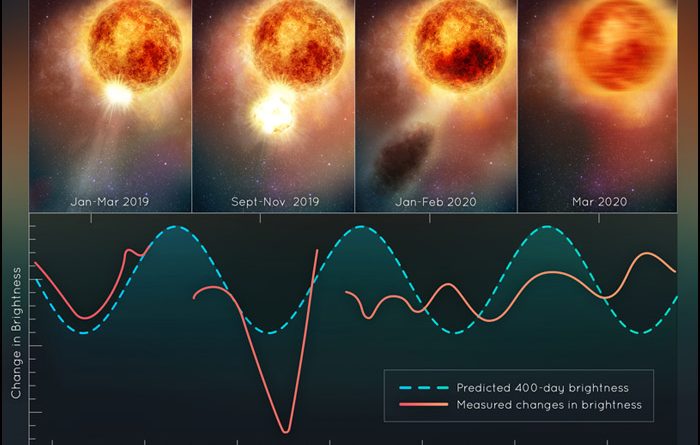Supergiant Star Betelgeuse Had Unprecedented Massive Eruption: Astronomers
Analyzing data from NASA’s Hubble Space Telescope and several other observatories, astronomers have concluded that the bright red supergiant star Betelgeuse blew its top in 2019, losing a substantial part of its visible surface and producing a gigantic Surface Mass Ejection (SME). This is something never before seen in a normal star’s behavior, according to NASA.
Sun routinely blows off parts of its tenuous outer atmosphere, the corona, in an event known as a Coronal Mass Ejection (CME). But the Betelgeuse SME blasted off 400 billion times as much mass as a typical CME.
The titanic outburst in 2019 was possibly caused by a convective plume, more than a million miles across, bubbling up from deep inside the star. It produced shocks and pulsations that blasted off the chunk of the photosphere leaving the star with a large cool surface area under the dust cloud that was produced by the cooling piece of photosphere. Betelgeuse is now struggling to recover from this injury.
The monster star is still slowly recovering from this catastrophic upheaval. “Betelgeuse continues doing some very unusual things right now; the interior is sort of bouncing,” said Andrea Dupree of the Center for Astrophysics | Harvard & Smithsonian in Cambridge, Massachusetts.
These new observations yield clues as to how red stars lose mass late in their lives as their nuclear fusion furnaces burn out, before exploding as supernovae. The amount of mass loss significantly affects their fate. However, Betelgeuse’s surprisingly petulant behavior is not evidence the star is about to blow up anytime soon. So the mass loss event is not necessarily the signal of an imminent explosion.
Dupree is now pulling together all the puzzle pieces of the star’s petulant behavior before, after, and during the eruption into a coherent story of a never-before-seen titanic convulsion in an aging star.
“We’ve never before seen a huge mass ejection of the surface of a star. We are left with something going on that we don’t completely understand. It’s a totally new phenomenon that we can observe directly and resolve surface details with Hubble. We’re watching stellar evolution in real time,” added Dupree.
Source: Read Full Article


